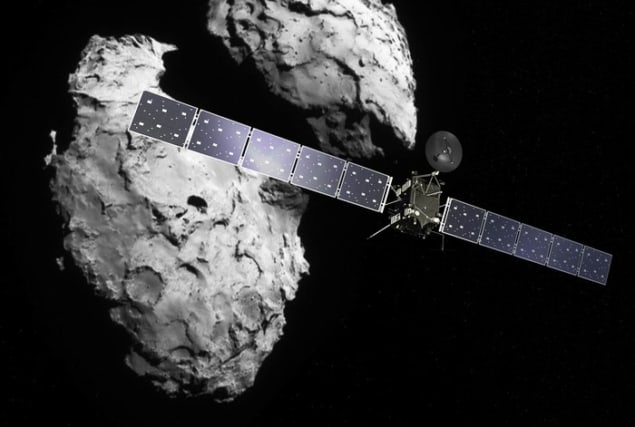
In 2015, the European Space Agency’s Rosetta spacecraft made a shocking discovery, detecting a large amount of molecular oxygen in the coma of gas surrounding the comet 67P/Churyumov-Gerasimenko. Oxygen was not expected in a cometary environment because the gas is reactive and the sheer quantity detected suggested that current theories of the chemistry of the early solar system could be wrong. Now, however, a new analysis of the Rosetta data suggests that the 2015 observations are not that surprising after all.
In this latest work, a team led by Adrienn Luspay-Kuti at the Johns Hopkins University Applied Physics Laboratory in the US conclude that the oxygen detected around 67P comes from two internal reservoirs in the comet – and is not indicative of overly large amounts of the molecule in the object.
“We discovered that the oxygen concentration in the comet, which everyone thought was super high, isn’t quite as high after all,” Luspay-Kuti told Physics World. “We are still not sure how exactly the oxygen got into the comet, but we made a huge leap forward in figuring it out,” she adds.
Tied up with water
Previous attempts at explaining the high oxygen measurement had focused on the observation that oxygen and water were present together in the coma. The conclusion reached by some scientists was that oxygen got tied up with water at the birth of the solar system and was then incorporated into 67P. Another possibility is that the oxygen was derived from water within the comet. However, these scenarios have significant conceptual problems, including why such high levels of oxygen were present when the comet was forming or how large amounts of oxygen can be produced in a comet.
To understand the relationship with water, Luspay-Kuti and her colleagues studied seasonal variations in oxygen levels around 67P. Like Earth, the comet spins on an axis that is tilted with respect to its orbit around the Sun. This means that the surface of 67P experiences distinct seasons as it orbits the Sun once every 6.5 years. The team looked at parts of the comet at key time intervals when the seasons changed from winter to spring and then from summer to autumn. This allowed them to study outgassing, which occurs when the icy body of a comet is warmed and releases gases into the coma.
The team found that oxygen and water were emitted when the surface of the comet was warm, but that the association between water and oxygen went away as the surface cooled. Instead, oxygen is linked with carbon dioxide and carbon monoxide during the cold season.
Staggered emission
The team concluded that they were observing the staggered emission of oxygen from two different reservoirs. They reckon that one reservoir is deep within the comet and contains oxygen that has been there since the comet was formed. The second reservoir is near the surface and is made of porous frozen water. The idea is that some of the oxygen escaping from the core becomes trapped temporarily in the frozen water reservoir. But then in the summer, some of this oxygen is released along with water as the ice heats up – creating the observed high oxygen levels in the coma.
“Only one of these reservoirs, the one that’s deep down the comet, is a window to the times before planet formation, whereas the other one is a secondary reservoir closer to the surface that temporarily withholds, traps and accumulates the oxygen,” she adds. “This latter reservoir is responsible for the apparent close link between oxygen and water and for the very high oxygen concentrations.” She adds that their analysis suggests that the oxygen deep within the comet has been there since the comet formed.

Rendezvous with a comet
Luspay-Kuti says the team’s results highlight the success of the Rosetta, which is the first mission to orbit – rather than flyby – a comet. “Our measurements for 67P have unprecedented spatial and temporal coverage, which is a huge step ahead from the previous flyby-only missions.” She adds, “This level of coverage and ability to watch how the comet changes in real time allow us to learn and understand things about this comet, and comets in general, that we had not been able to before.”
How unique 67P is among comets remains to be seen, but its importance to science as the first comet visited by a mission is clear to Luspay-Kuti. “Comets were essentially the building blocks of the planets and other planetary bodies, and as such, they carry key information about the conditions in our solar system from before and after planet formation. So, if we want to understand the origins of our solar system, we must first understand how comets formed and how they evolved over time.”
The research is described in Nature Astronomy



